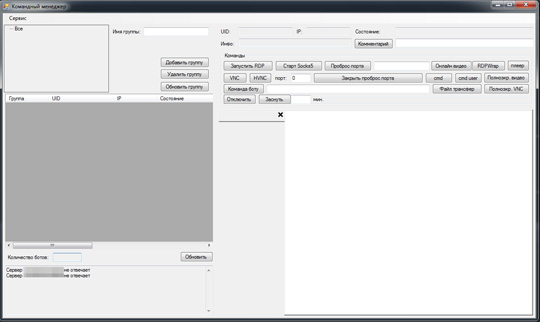Backdoor.MSIL.CARBANAK.A
Troj/Carbanak-B (Sophos AV), W32/Agent.QWIHBW!tr (Fortinet), Trojan.MSIL.Agent.qwihbw (Kaspersky)
Windows


Threat Type: Backdoor
Destructiveness: No
Encrypted: No
In the wild: Yes
OVERVIEW
This Backdoor arrives on a system as a file dropped by other malware or as a file downloaded unknowingly by users when visiting malicious sites.
TECHNICAL DETAILS
Arrival Details
This Backdoor arrives on a system as a file dropped by other malware or as a file downloaded unknowingly by users when visiting malicious sites.
Other Details
This Backdoor requires the following additional components to properly run:
- properly setup of:Backdoor.MSIL.CARBANAK.AA
- {Malware filepath}\CmdManager.xml ← servers IP:Port
It does the following:
- It requires password to connect to its C&C server:

- After success authentication it will display the following to manage BOTS databases save in C&C server:

C&C Server:- Add, update and remove Bots
- Add comment, status
- Bots:
- Video recording
- Execute commands specified in the configuration file
- Set the loaded state of the bot
- Use specified proxy settings
- Create or deletes a user with rights for RDP
- Delete specified service or file
- Download and executes a file in memory
- Take a screenshot and sends it to the C&C server
- Run VNC plugin
- Uninstall bot
- Update bot
- After success authentication it will display the following to manage BOTS databases save in C&C server:
SOLUTION
Step 1
Before doing any scans, Windows 7, Windows 8, Windows 8.1, and Windows 10 users must disable System Restore to allow full scanning of their computers.
Step 2
Note that not all files, folders, and registry keys and entries are installed on your computer during this malware's/spyware's/grayware's execution. This may be due to incomplete installation or other operating system conditions. If you do not find the same files/folders/registry information, please proceed to the next step.
Step 3
Identify and terminate files detected as Backdoor.MSIL.CARBANAK.A
- Windows Task Manager may not display all running processes. In this case, please use a third-party process viewer, preferably Process Explorer, to terminate the malware/grayware/spyware file. You may download the said tool here.
- If the detected file is displayed in either Windows Task Manager or Process Explorer but you cannot delete it, restart your computer in safe mode. To do this, refer to this link for the complete steps.
- If the detected file is not displayed in either Windows Task Manager or Process Explorer, continue doing the next steps.
Step 4
Scan your computer with your Trend Micro product to delete files detected as Backdoor.MSIL.CARBANAK.A. If the detected files have already been cleaned, deleted, or quarantined by your Trend Micro product, no further step is required. You may opt to simply delete the quarantined files. Please check the following Trend Micro Support pages for more information:
Did this description help? Tell us how we did.
